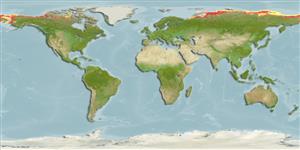>
Salmoniformes (Salmons) >
Salmonidae (Salmonids) > Coregoninae
Etymology: Coregonus: Greek, kore = pupils of the eye + Greek, gonia = angle (Ref. 45335); sardinella: sardinella meaning small sardine (Ref. 1998).
More on author: Valenciennes.
Environment: milieu / climate zone / depth range / distribution range
экология
морской; пресноводный; солоноватоводный; анадромный (Ref. 51243). Polar; 78°N - 62°N, 45°E - 95°W
North America: Murchison River, Canada to Bristol Bay, Alaska; ascends Yukon River to British Columbia, and Mackenzie River to Fort Simpson (Ref. 5723). Asia: Bering Sea, Chukot land and Kolyma River to Kara River on the northern end of the Urals (Ref. 593). Lakes and lower course of large rivers of Arctic Ocean basin from Pechora drainage to eastern Siberia (Ref. 59043). Belongs to Coregonus artedi complex. Occasionally hybridizes with Coregonus nelsoni (Ref. 27547).
Size / Вес / Возраст
Maturity: Lm ? range ? - ? cm
Max length : 47.0 cm TL самец/пол неопределен; (Ref. 5723); common length : 23.0 cm TL самец/пол неопределен; (Ref. 1998); наибольший вес (опубликованные данные): 555.00 g (Ref. 593); наибольший возраст (опубликованны данные): 26 годы (Ref. 1998)
колючие лучи спинного плавника (общее число): 0; членистые (мягкие) лучи спинного плавника (общее число): 12-14; колючие лучи анального плавника 0; членистые (мягкие) лучи анального плавника: 10 - 13; позвонки: 58 - 64. Body elongate, somewhat compressed laterally, greatest body depth at front of dorsal fin. Head about 19 - 24 % of total length; eyes large; snout length usually less than eye diameter; mouth moderate, terminal, lower jaw always protruding, maxillary at a distinct angle, extending posteriorly to below anterior half of the eye; a small cluster of teeth present on the tongue. Overall coloration silvery, usually brown to dark green on the back, becoming silvery on sides and below. The small non-anadromous form that remains in fresh water is without spotting on the back and only the pelvic fins have black pigment on the tips., the remaining fins are unpigmented. The larger, anadromous form has dark spots on the head, back, dorsal, and adipose fins, and sometimes, on the pectoral fins; all fins have usually dark pigment on the tips.
Adults occur in coastal waters, estuaries, large lakes and rivers (Ref. 5723). Lake-dwelling populations appear to be non-migratory, while those found in streams or brackish water move considerable distances to reach or leave spawning sites (Ref. 27547). Semi-anadromous populations forage in estuaries, lower courses of rivers, backwaters and lakes (Ref. 59043). Nerito-pelagic (Ref. 58426). Feed on planktonic crustaceans and insects (Ref. 1998); also plant material (Ref. 27547) and fishes (Ref. 58426). Do not usually feed during its spawning run (Ref. 28219, 28860, 28861). Migratory forms are observed to live longer than fresh water forms (Ref. 1998). Spawn in deep pools on sand and gravel (Ref. 59043). Flesh is said to be tasty (Ref. 1998).
Spawning occurs at night, peaking between 8 pm and midnight. A female spawns almost vertically upward, with her ventral side upstream. She is joined by as many as five males who swim vertically and close to her. As the spawners approach the surface, eggs and milt are released. The fish break the surface, fall over backward, and swim back to the bottom of the pool (Ref. 27547).
Page, L.M. and B.M. Burr, 1991. A field guide to freshwater fishes of North America north of Mexico. Houghton Mifflin Company, Boston. 432 p. (Ref. 5723)
Статус Красного Списка МСОП (Ref. 130435)
Угроза для людей
Harmless
Использование человеком
рыболовство: коммерческий; объект спортивного рыболовства: да
дополнительная информация
ссылкиаквакультура (рыбоводство)особенности рыбоводствастепень растяжениягенетикаElectrophoresesнаследуемостьболезниобработкаNutrientsMass conversion
соавторыизображенияStamps, Coins Misc.звукиCiguateraскоростьтип плаванияжаберная областьOtolithsмозгзрение
инструменты
Специальные отчеты
Скачать в формате XML
ресурсы в Интернет
Estimates based on models
Preferred temperature (Ref.
123201): -1.8 - 2.7, mean -0.8 °C (based on 1616 cells).
Phylogenetic diversity index (Ref.
82804): PD
50 = 0.5000 [Uniqueness, from 0.5 = low to 2.0 = high].
Bayesian length-weight: a=0.00437 (0.00373 - 0.00511), b=3.21 (3.17 - 3.25), in cm total length, based on LWR estimates for this species (Ref.
93245).
Trophic level (Ref.
69278): 3.2 ±0.2 se; based on diet studies.
устойчивость к внешним воздействиям (Ref.
120179): средний (среднего размера), минимальное время удвоения популяции 1.4-4.4 года (K=0.40; tm=2-4; tmax=11; Fec=2,500).
Prior r = 0.51, 95% CL = 0.34 - 0.76, Based on 2 stock assessments.
Fishing Vulnerability (Ref.
59153): Moderate to high vulnerability (52 of 100).
Nutrients (Ref.
124155): Calcium = 20.4 [9.1, 37.8] mg/100g; Iron = 0.52 [0.25, 0.99] mg/100g; Protein = 18.1 [16.9, 19.3] %; Omega3 = 0.696 [0.272, 1.918] g/100g; Selenium = 11.1 [4.1, 30.5] μg/100g; VitaminA = 6.92 [1.15, 41.73] μg/100g; Zinc = 0.521 [0.395, 0.737] mg/100g (wet weight);
